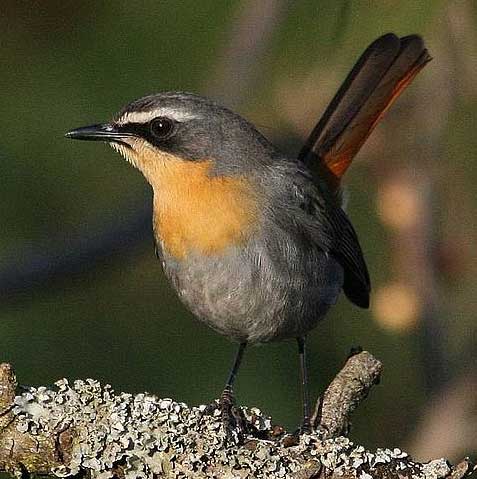Cossypha caffra (*) Cladus: Eukaryota Name Cossypha caffra (Linnaeus, 1771) Vernacular names Reference Mantissa Plantarum altera, &c. p.527 --------- The Cape Robin-Chat, Cossypha caffra, is a small passerine bird of the Old World flycatcher family Muscicapidae. It is a mainly resident breeder in southern and eastern Africa from Kenya south to Namibia, Zambia, Zimbabwe, South Africa, Lesotho, and Swaziland. It is a common species at forest edges and in scrub, fynbos, karoo, plantations, gardens and parks. Description The Cape Robin-Chat is 16–17 cm long. The adult’s upper-parts are grey, and the face sides in front of and behind the eye are blackish, separated from the crown by a white supercilium. The chin, throat, central breast, rump, under-tail coverts and outer tail feathers are orange, and the central tail feathers are greyish-brown. The belly is pale grey. The black bill is short and straight, with a slightly down-curved upper mandible. The legs and feet are pinkish grey, and the eye is brown. The sexes are similar, but the juvenile is dark brown above and buff below, heavily marked with buff on the upperparts and grey-brown on th breast. The Cape Robin-Chat has a harsh, low trisyllabic alarm note "WA-dur-dra". The Afrikaans name name for this species, “JAN Frederik” gives the rhythm of this call, if the syllables of the latter part are run together. The song consists of variable short passages of musical notes, always starts with low slurred whistle cherooo-weet-weet-weeeet. Behaviour The Cape Robin-Chat builds a cup-shaped nest of coarse vegetation, lined with animal hair, rootlets and other fine material. It normally nests from June to November in the South-western Cape and August to January elsewhere, but may nest at any time of the year. It eats insects, spiders and other invertebrates, small frogs, lizards and some fruit. * Ian Sinclair, Phil Hockey and Warwick Tarboton, SASOL Birds of Southern Africa (Struik 2002) ISBN 1-86872-721-1 Source: Wikispecies, Wikipedia: All text is available under the terms of the GNU Free Documentation License |
|

